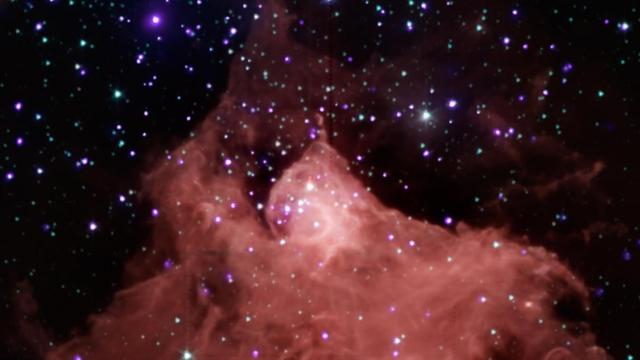A team of researchers say they’ve found some building blocks of RNA in a molecular cloud close to the centre of the Milky Way. The discovery has implications for theories about how life began on Earth — and perhaps elsewhere.
The molecular cloud is named G+0.693-0.027. The team of astrophysicists, astrobiologists, and chemists conducted a survey of the cloud using two telescopes in Spain to unpack details of its chemistry.
Ribonucleic acid (RNA) is a molecule present in all living cells that behaves similarly to DNA, though it is single stranded. There is evidence that RNA could have preceded DNA, based on laboratory observations of ribosomes, which are made up of RNA.
Whether or not ancient RNA could have jumpstarted life, though, is another matter. The recent team found several organic molecules in the cloud that are part of a group called nitriles, which may have been important in generating RNA in the early universe; the team’s results were published today in Frontiers in Astronomy and Space Sciences.
“Here we show that the chemistry that takes place in the interstellar medium is able to efficiently form multiple nitriles, which are key molecular precursors of the ‘RNA World’ scenario,” said Víctor Rivilla, an astrobiologist at the National Institute of Aerospace Technology in Madrid, in a Frontiers release.
The RNA world hypothesis posits that RNA with genetic and metabolic activity was fundamental in the origins of life. A couple of studies in the 1990s showed that RNA could have jumpstarted life as we know it, because it could do genetic work like DNA but could catalyze reactions like proteins. There are also problems with the theory, but it’s nonetheless interesting to consider.
“There are still key missing molecules that are hard to detect,” said Izaskun Jiménez-Serra, an astrophysicist also at the National Institute of Aerospace Technology, in the same release. “For example, we know that the origin of life on Earth probably also required other molecules such as lipids, responsible for the formation of the first cells. Therefore we should also focus on understanding how lipids could be formed from simpler precursors available in the interstellar medium.”
The earliest evidence of life on Earth comes in the form of 3.5-billion-year-old stromatolites, sedimentary concretions generated by ancient bacteria as they grew. If there’s fossilized life on Mars, the best guess is that it probably looks something like that.
But before stromatolites, something was needed to seed life after Earth formed. One theory is that whatever ingredients were needed for life arrived on Earth around 4 billion years ago (give or take several hundred million years), in a period called the Late Heavy Bombardment.
During the bombardment, the Earth and Moon were slammed by asteroids and comets, the evidence of which is now baked into the planet’s crust (and the Moon’s surface). It’s possible that nitriles like those found by the recent team arrived on some of those ancient asteroids, just as liquid water is proposed to have gotten to our planet.
Nitriles have also been found in various protostars, meteorites, and even in the atmosphere of Titan, Saturn’s largest moon. It’s a reminder that we’re in a big cosmic soup that’s been stirred for billions of years — ingredients are floating around everywhere.
“The chemical content of G+0.693-0.027 is similar to those of other star-forming regions in our galaxy, and also to that of solar system objects like comets,” Rivilla said. “This means that its study can give us important insights about the chemical ingredients that were available in the nebula that give rise to our planetary system.”
Rome wasn’t built in a day, and neither was life on Earth. However life did emerge, though, it required things like RNA to get started. Where that RNA came from remains a mystery, but the fact that its building blocks can be found even near the centre of the Milky Way indicates that organic molecules are diffuse throughout our galaxy. Whether that means life is, too… well, scientists will just have to keep looking around.
More: Scientists Found a New Window Into the Hellish Ancient Earth
